Meghan Houlihan is the renewable energy program director for the Northeast Sustainable Energy Association, based in Greenfield, Mass. She periodically abandons her desk job to work as a web editor aboard Greenpeace vessels.

Monday, 2 Feb 2004
PUERTO AISEN, Chile
Back in bucolic little Vermont — my homeland — I wouldn’t need an alarm clock to wake me at 6:00 in the morning. But I’m in Chile, I’m reminded, as my eyes struggle to open just in time to see Chilean people only slightly younger than I am returning from a night of revelry. The window of my cabana reveals the sun just beginning to peek out from behind the mountains, and I have a long day ahead.

A view of Meghan’s hotel in Puerto Aisen.
Before I explain how I came to be here, down in spectacular Puerto Aisen in Patagonia, I should, by way of introduction, describe a soccer game held several nights ago. A contingent of about 20 Greenpeace people came here early last week to get acquainted with the local community and begin dialogue about the Alumysa project, a series of hydroelectric dams and an aluminum plant proposed for this area. Brainchild of Noranda, a Canadian company that has left a trail of environmental destruction around the world, Alumysa would result in the flooding of more than 24,700 acres of ancient forest. The Alumysa smelter would produce approximately 1.5 million tons of gaseous and solid waste each year, including fluorides, cyanide, and arsenic. But as in many other parts of Chile, the economy here is quite poor, and the promise of jobs is difficult to resist.
So my Greenpeace colleagues, after meeting various community members and holding some soft demonstrations to generate discussion about Alumysa, found themselves challenged to a game of soccer by the local police. Now, Chileans take their soccer very seriously, and the young, energetic Greenpeace volunteers were no different. With great excitement they accepted, and the teams met one fateful evening for a mighty battle.
It was clear from the start that we were in deep trouble. The professional stripes of the police team uniforms stood in stark contrast to the grubby T-shirts donned by the Greenpeace contingent. The police team moved with the precision of a hawk approaching its prey, communicating in that unspoken way characteristic of longstanding relationships — and expert players. The Greenpeace team, tireless, enthusiastic, and with the grace of a dog wearing a blindfold, held its own, scoring five goals, despite the fact that the police team had brought in a professional goalie (“foul!” we cried). The final score? Five to 30, a defeat of epic proportions.
The lesson? Some losses are okay.
So now we await the arrival of the Greenpeace ship Arctic Sunrise at Chacabuco, a nearby port, where we will begin a tour to draw attention to the plight of Chile’s ancient forests. By this evening, I will be situated on the ship, where I will maintain a website to communicate to the public about our tour, and, of course, to keep you informed about other lessons learned during the week ahead.
Tuesday, 3 Feb 2004
CHACABUCO, Chile
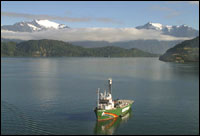
The Arctic Sunrise.
Photo: Daniel Beltra, Greenpeace 2004
Good morning! I’m writing from the Arctic Sunrise, a Greenpeace ice-breaking vessel that has navigated around — and through — ice floes in the Arctic, been rammed by Japanese whalers in the South Pacific, and put itself in the path of U.S. missile testing. It’s a special ship with a rich history. We have just commenced an expedition in the waters around Chile’s Patagonia region to document its threatened ancient forests and generate awareness of those threats.
Today marks my first “real” day as a crew member on board, which means I was subjected to the usual 7:30 a.m. wake-up knock, a soft “good morning” in an accent I couldn’t identify (yes, I have adjusted to the Chilean schedule described in my previous dispatch). That was followed by a safety tour of the ship (in which first mate Madeline encouraged newcomers not to set fires or rush back to the cabin for pictures of Mum during an emergency), and the morning cleaning ritual, which includes scrubbing toilets and mopping floors. This is my third voyage on a Greenpeace vessel, so I had the good sense to claim the “lounge” for cleaning duty before anyone could beat me to it (it consists of rinsing beer cans and vacuuming — vastly preferable to the toilets).
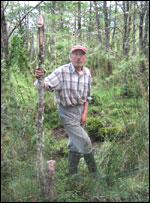
Don Diego.
Photo: Daniel Beltra, Greenpeace 2004
Today we’re preparing for a press conference on board. We’ll present findings from the previous leg of our Patagonian tour, which focused on global-warming impacts in southernmost Argentina and Chile, and we’ll announce the three-week forests expedition we have just begun. Yesterday I mentioned the Alumysa project that mining company Noranda proposes to build in this area — an aluminum smelter and hydroelectric dams. A few days ago, members of our team went to visit with families who live in one of the areas that will be flooded if Noranda is allowed to build dams for the hydro plant. The local residents, such as Don Diego, aren’t so keen on Noranda’s proposal. Even though Noranda can offer him large sums of money to relocate — a strong enticement when one lives in poverty — Don Diego refuses to give up his land.
Looking out at this spectacular landscape and breathing in this clean air, it’s difficult to imagine such a polluting industry moving in. But then, I suspect that the same thing could have been said of other areas around the world that are now industrial wastelands.
Now is not the time for such grim ponderings, however — too lovely a day, and I’m called back to the tour website, which I will be updating from the ship. And since I’ve been hunched over a table writing this entry — all chairs on board have been claimed for the press conference (a demanding bunch, those journalists) — I will give my back a break and sign off.
Wednesday, 4 Feb 2004
CHACABUCO, Chile
Warning: Those of you who are fed up with the routine, mundane nature of your indoor desk jobs are advised to skip today’s entry. You’ll only feel worse.
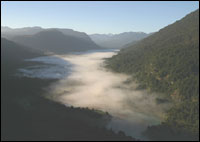
A Chilean valley to be flooded by the Alumysa project.
Photo: Daniel Beltra, Greenpeace 2004
Buenos tardes! I’m writing to you somewhat sheepishly from a hammock on the deck of the Greenpeace vessel Arctic Sunrise. To my left are the snow-capped peaks of the coastal mountains here in Patagonia, straight ahead is the small fishing port of Chacabuco, and to my right are verdant hills from which a condor just descended. I can’t help but think that if everyone could experience such beauty, there would be more peace and happiness all around. (Those are clearly the words of someone drunk on sun. Hiccup.)
It’s a quiet day on the ship. Most members of the Spanish-speaking crew have left to join 13 kids who are camped in one of the areas that will be flooded by Noranda’s Alumysa project (see Monday’s dispatch for details). The children are members of “Kids for Forests,” an international project Greenpeace launched to encourage youth involvement in protecting threatened forests. The kids participate in all kinds of ways, including leafleting, meeting with public officials (young people have such a knack for explaining things clearly and simply!), and attending international conventions. And, of course, camping. The “campaigner contingent” staying on the ship (project leaders, press officers, logistics coordinators, etc.) is in Puerto Aisen, meeting with a number of other Chilean NGOs to discuss strategies for stopping the Alumysa project.
Being neither a Spanish-speaking crew member nor someone who needs to attend meetings, I am, well, here in the hammock. This is probably the part where I should fess up and tell you that the Spanish I have been interjecting periodically throughout these updates is merely to impress you — I barely speak a word, and have become completely accustomed to that look of utter bafflement that results from my feeble attempts to communicate. Fortunately, in this country, smiling and enthusiasm go a long way.
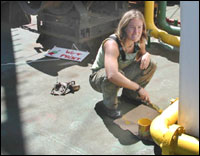
A typical day on a Greenpeace boat.
Photo: Greenpeace.
As I type away, putting expedition updates on the ship tour website and snapping photos of crew members before they can stop me, most of those remaining on board are busy painting. If you’re curious as to what people actually do on Greenpeace ships when not blocking whaling vessels or cargo ships carrying ancient forest wood, that’s usually the answer. Yesterday they chipped paint. Today they paint. Tomorrow they will chip paint. The day after … and so on. Of course, that’s an oversimplification. Running the ship is an enormous undertaking — there are engineers, outboard mechanics, and most importantly, cooks.
The cooks deserve their own paragraph. They control the quality of your life on board the ship. They are providers. They are artists. They have, by far, the most difficult job. During this trip, for example, they are cooking for 34 people, seven days a week, 10-plus hours a day. To make matters worse, they have to cater to a range of special diets — vegetarian, vegan, peanut allergies, etc. In fact, my cabin-mate Monica from the Chilean office is extremely allergic to pepper, so they have had to stop using it in most of the dishes they prepare.
But the results are divine. And Rosano, the head cook, who speaks passionately about protecting the world’s ancient forests, is equally passionate about only one thing: “You’ll get very fat on this ship, Meghan,” he told me proudly while sitting on deck the other night. “That’s what I’m here to do.” So far, so good.
Thursday, 5 Feb 2004
CHACABUCO, Chile
Good (yawn) morning! I’m writing to you very early on this Thursday, because at 7 a.m. I will be taking a boat to shore and going to Lago Caro — or Caro Lake — where the “Kids for Forests” group is camping. Lago Caro is in a remote area, a good three-hour drive from the fishing port of Chacabuco, where the Arctic Sunrise is currently at anchor. If mining company Noranda succeeds in constructing a hydroelectric facility for its proposed aluminum smelter, the area will be ravaged by industry, and thousands of acres of ancient forest around Lago Caro will be lost to flooding caused by dams.
I’m looking forward to spending more time with the kids, who range in age from 11 to 17 years old. Part of my job as the web editor on the ship is to capture stories about the people involved in our work and to use those stories to inspire and educate others. Usually that entails walking around with a mini-disk recorder, a microphone, headphones, and a digital camera, inevitably getting in people’s ways. But the kids, who have been at the lake for three full days now, will be glad for the diversion, I’m sure. And I have no question that their stories will inspire.
Their involvement with Greenpeace begins at the schools. Greenpeace volunteers throughout the country set up information tables about the Kids for Forests program on playgrounds. Kids who are interested in getting involved can sign up to receive more information, including action alerts. The volunteers also work closely with teachers, helping them integrate forest-related issues into the curriculum. In this way, more than 6,000 students at more than 30 schools in Chile have become involved in the program. When a forest-related campaign begins, such as the one we are currently undertaking, each school can nominate one of its students to become part of the core campaign team. The 13 kids now at Lago Caro are the select few who were invited to participate this year.
In addition to protesting Noranda’s proposed aluminum smelter, the kids have been actively generating support for forest protection in the lead-up to the U.N. Convention on Biological Diversity, which will take place in Kuala Lumpur, Malaysia, this month. The kids have written letters to and have held meetings with Chilean public officials, asking them to take action to protect Chile’s ancient forests at the CBD. They also organized an exhibition of photos and drawings for local officials in Punta Arenas, where the Arctic Sunrise first docked in Chile. Three of the kids will go to the CBD in Malaysia next week to meet with representatives and present drawings and messages prepared by young people across the country.
One of the student delegates, Manuel, lives in Puerto Aisen, a town near us here in Chacabuco. Puerto Aisen is an economically depressed place where opportunities are extremely limited. Manuel was abandoned by his parents when he was young and was taken in by his aunt, who has done everything possible to try to give him a better life. His involvement with forest protection efforts in Chile and his upcoming trip to Malaysia have been widely publicized and have inspired young people across the country.
Well, I’m going to be thrown overboard if I’m late for the ferry (a zippy little Greenpeace inflatable, of course), so I’ll sign off.
P.S. Don’t forget to visit our expedition website.
Friday, 6 Feb 2004
CHACABUCO, Chile
Good afternoon! When I wrote yesterday, I was on my way to Lago Caro to meet with the Kids for Forests activists, so now you’re probably waiting with bated breath to learn how my day went. I will keep you in suspense no longer …
We left Chacabuco, where the Arctic Sunrise is presently anchored, with a cadre of crew members, campaigners, and assorted other tagalongs, bright and early yesterday morning. It takes three hours by bus to get from Chacabuco to Lago Caro, so I dutifully carried my laptop along, intending to get some work done on the ship tour website.
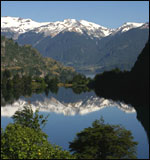
Scenery that’ll knock your socks off.
Photo: Daniel Beltra, Greenpeace 2004
I hadn’t counted on the scenery, however (silly me — you’ve seen some of the photos!), and could barely tear my gaze from the window. On the right was a deep, verdant valley with a turquoise river running through it, and on the left, lush forests. Fuchsia bushes lined the road (I thought they only grew in pots!), as did foxglove (or something that looks very similar) and the most beautiful mosses in every shade of green.
After three hours of intense visual stimulation, we arrived at the area where the kids were camping. It was a flat, grassy plateau in the valley, with a small community center shared by the eight families who live in the area. A deep, narrow river separated the road from the camp — we were ferried across by one of the locals and greeted by about 60 people on the other side. Some were members of local families; others had come from various places in the Aysen region to participate.
“Participate in what?” you ask, hoping, perhaps, for an exciting story about confrontation and police chases. But we didn’t want to do an “action” in the traditional Greenpeace style, we just wanted to show that there is strong local opposition to the Alumysa project. So we decided to use bodies to create a human message down in the valley, which will be under water if mining company Noranda moves forward with Alumysa. (I couldn’t tell you about our plans yesterday, of course — Greenpeacers are expert secret-keepers. We like surprises.)
The activity was great fun and gave us the chance to interact both with the youth activists and the local residents. (I was on the “Y” team, which prompted us to burst into the widely international and long-outdated song by the Village People.) It was also harder than it looks. When nearly 100 people are lying on the ground in various shapes, it’s difficult to gauge how it will look from a camera — and in this case, the camera was in Tweety, the helicopter that resides on the Sunrise.
So we patiently braved the searing Patagonian sun and laid on rocks and dirt and small crawling things while the helicopter flew overhead. “Done?” we’d ask, spitting sweat and dirt out of our mouths. “One more!” said the voice on the radio. Finally the helicopter crew came back, at which point we discovered that the pictures were unusable: It was too difficult to make out our shapes on the light brown earth. Okay, on to Plan B (Greenpeacers are also extremely flexible). But first we ate a delicious vegetarian meal of red peppers and cucumbers and pasta, sharing our mealtime with nearly 10 parrots that were perched in a nearby tree.
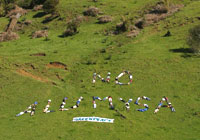
A (human) banner day.
Photo: Daniel Beltra, Greenpeace 2004
When we had properly digested our food and chatted with our friends, we did some scouting and found a nice grassy area (green is a good background color) in the valley where the human banner would stand out better. After some manipulations, using fewer people to create more compact letters, we got it right, and the photographer got his shots. Whew! It’s tough to lie around on Patagonian earth while gazing out at rivers and mountains and … (are you plugging your virtual ears, telling me to shut up now?).
We finally left Lago Caro around 6 p.m., bidding farewell to our new friends, all of us feeling that we’d just experienced our best day yet. I’m sure there will be more, but as this is my last entry, you’ll have to visit the ship tour website to learn about them.
Now we prepare for open boat days, when we open the ship to visits from the public. When the Arctic Sunrise was in little Punta Arenas in the southernmost part of Chile, a five-hour open boat day attracted more than 3,000 people! We’re not expecting such a large turnout here, but one never knows. Next week we move north to Puerto Montt, where we will turn our attention to the Valdivian rainforest, the world’s second-largest coastal temperate rainforest.
Next week also marks the beginning of the Convention on Biological Diversity in Kuala Lumpur, Malaysia, where world leaders will meet about the fate of the world’s remaining forests and marine ecosystems. In 2002, world governments committed themselves to “move from dialogue to action” and to “strengthen efforts to halt biodiversity loss.” This year’s meeting will determine whether it’s an honest commitment or, well, hot air. Having spent some time now in Patagonia’s ancient forests, and seeing the implications of failing to protect them from industry and other private interests, it is difficult to overstate how much we stand to lose.
Thanks for reading. I hope you’ll continue to follow us on our journey.
Por los bosques,
Meghan

